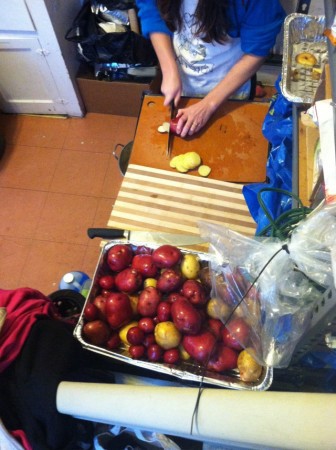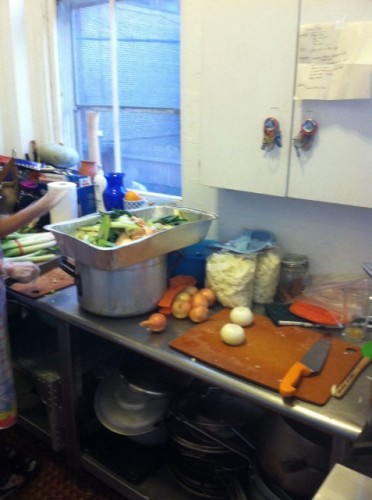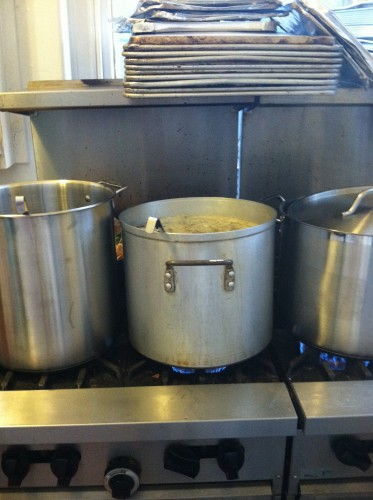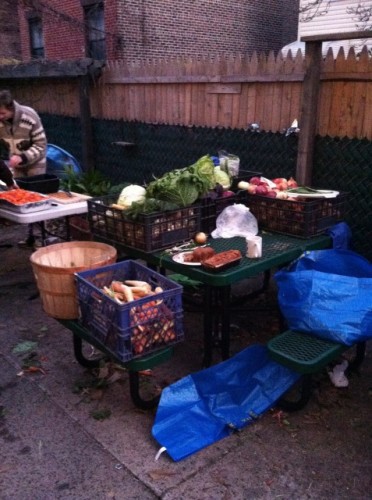How To Cook For Between 10 And 250 People After A Disaster And/Or Over The Holiday

In the aftermath of Hurricane Sandy, volunteers have spontaneously organized to help the many, many people whose homes were destroyed or damaged by the storm. Many displaced or electricity-lacking NYC residents are still in need of hot meals. Occupy Sandy has been coordinating deliveries and making some food at their hubs in Brooklyn, but a lot of the food they’re distributing is coming from various kitchens in churches and schools and even homes, and some of those volunteers are also finding ways to deliver the food themselves. (Here’s what’s happening and where to help for Thanksgiving.)
This outpouring of community support gives me a schizoid blend of alternately heartwarmed and terrified feelings. On the one hand, it’s inspiring to see people band together in this way, but on the other hand, it’s deeply scary to know that, right after the storm, a loose web of volunteers were the only sources of food for a lot of people. We live in weird times. It seems like knowing how to cook for a lot of people is an important life skill for right now and the scary looming climate-changed future. Sorry to be so apocalyptic! Many of these tips are also applicable to your big family Thanksgiving.
Ann Carroll has been coordinating volunteer efforts at the Greenpoint Reformed Church nearly every day since the storm. Ann got involved with volunteering at the church’s soup kitchen a few years ago, at around the same time that she was transitioning from restaurant cooking to grad school for medieval studies. Now she not only helps cook dinner for around 80 soup kitchen clients every week that she can, she also cares for a thriving garden in the church’s backyard and runs a supper club that helps the kitchen buy food in the lean winter months, when CSA-donated vegetables aren’t in season.
I quizzed Ann about her tactics last Thursday as she drove 250 meals’ worth of potato soup, squash soup, broccoli-cauliflower gratin, braised greens and boiled carrots that she and a handful of volunteers had just finished cooking from Greenpoint to the Occupy Sandy hub in the Church of St. Luke and St. Matthew at 520 Clinton Avenue.
Like a lot of cooks, Ann considers a lot of what she does obvious or intuitive, but a lot of what she considers second-nature came as a surprise to me when I first saw her at the stove. I asked her to break it down for people who don’t typically find themselves cooking for a crowd — i.e., most people, even really good home cooks. Here, I’ve combined what she told me with descriptions of what I saw her doing.
First, I asked her to imagine herself confronted for the first time with the rudiments of large-scale cooking: a few big pots and pans, a large quantity of motley, maybe-great, maybe-gross donated vegetables, meats or canned goods, an envelope with a small amount of cash in it that has to be stretched to buy salt, herbs, oil, milk, butter, and dollar-store aluminum trays. What’s the first thing to do?
“Cut up onions and garlic,” she said without a pause to think. “Because they go in everything.”
1. FIRST CUT UP ONIONS AND GARLIC, BECAUSE THEY GO IN EVERYTHING.
Okay, I said. What’s next?
“Get the soup out of the way. Oh, or if you’re serving potatoes or rice as the starch — get those started.”

2. GET THE SOUP OUT OF THE WAY
Here’s Ann’s recipe for the soup she made last Thursday, which is adaptable to almost any vegetable and any season. First, melt as much butter as you can spare plus some olive oil, or just olive oil if you haven’t got butter, at the bottom of a gigantic pot. Then add a thick layer of sliced onions and garlic — you can fill the pot about a quarter full, because of how much the onions cook down. Add bay leaves and a bunch of thyme, which you’ll fish out later if you remember to. Add a bit of salt, to help onions cook down, but not too much — you can always add salt, but you can’t take it out, so it’s best to season at the end.
When the onions are translucent, fill the pot almost full of cut-up vegetables — not a random motley combination of veggies if you can help it, maybe one or two thematically linked vegetables. Broccoli and cauliflower. Leeks and potatoes. A bunch of cans of corn, in a pinch. Potatoes or turnips are always a welcome addition. Your goal is to make as much of everything as possible, so as you eyeball quantities, always err on the side of more. Last Thursday the vegetables were squash, rutabagas and potatoes.
Add liquid — stock if you’ve got it, but in all likelihood water — just to cover, bring to a boil (this might take approx. forever), then reduce the heat to a simmer while you make everything else.
When the rest of the meal is cooked, finish the soup by partly pureeing it. An immersion blender does a great job of this, and if you forgot to remove the thyme bunch it’ll do that for you by winding the twigs around its blade. A potato masher works too. If you’re adding milk, cheese or sour cream, now is the time, but don’t bring the soup back to a boil after this addition — it might curdle. Season with salt and pepper.

3. MAKING LOTS OF POTATOES OR RICE
Try to avoid having to peel potatoes. If they’re anything other than russets, you can get away with just scrubbing. You can put way more potatoes in the pot than you’d think. Ditto pasta, although you have to stir to keep it from sticking.
Making a giant pot of rice seems daunting because of rice’s mysterious nature — for small quantities, we’re used to putting the lid on and hoping for the best. It helps to know that if you take the lid off your giant pot of rice and it has absorbed all the water but is still crunchy, you can add more water (!!) and it will come out fine. As with seasoning, you can’t take something out, but you can always add. Don’t stir. Don’t stir rice. Just don’t stir it, ever.
When the potatoes are cooked through, drain them and then mash them with as much milk and butter as you can. They can absorb a lot.
4. ACTUALLY, ABOUT STIRRING IN GENERAL: COOL IT!
A lot of times we think we have to “look busy” in the kitchen. If you stop moving things around so much, it gives them a chance to cook evenly or caramelize. With a few exceptions, you can ignore food while it cooks much more than you might think.
5. WINTER VEGGIES AND GREENS: DEFAULT RECIPES THAT ALWAYS WORK
If life gives Ann carrots or other roots — parsnips, rutabagas, turnips — she likes to cut them into uniform chunks or coins and sauté them on high heat with butter or olive oil, a little tiny bit of white sugar to help them caramelize, and thyme. (She loves thyme — it’s cheap, readily available, lasts a long time and tastes good in almost everything. It also has natural antibiotic properties, which can’t be a bad thing.)
Don’t overstir. Deglaze the pan with stock, wine, or — most likely all you’ve got — water.
Tender greens go in salad. Tougher greens — chard, bok choy, kale, collards, tat soi, etc. — are great braised. Ann starts a pot with onions and garlic, as for soup, then adds washed, un-drained (i.e., wet) greens, adding extra liquid if they’re too dry, and a bit of brown sugar.
6. WHERE’S THE MEAT?
Ann is a vegetarian, so she doesn’t love to cook meat. These meals are going to be transported for a long time and might not be able to be reheated to a safe temperature — it’s probably safer not to have meat in these situations. She has been getting donations of ham and other cold cuts, which she chops into cubes and incorporates into baked pasta dishes or potato gratins.

7. GRATINATE IT!
Ann’s technique for making rich, delicious casseroles could not be simpler. First, she steams the vegetables in the trays they’ll be served in, by covering them with a bit of water and putting their lids on then sticking them in the oven til they’re crisp-tender. Then she makes a béchamel sauce — a roux of flour and butter or oil, to which milk is slowly added — and tops up the trays with it. She then adds a layer of shredded cheese, when available, and pops the trays back in the oven.
8. HERE, SAVE YOURSELF SOME PREP TIME.
If you can get away with it — if they’re not totally filthy or hairy — avoid peeling organic vegetables. Peels are good for you!
8. HOW HOT IS THE OVEN?
350–375.
9. HOW LONG DO THINGS COOK?
Til they’re done or it’s time to serve or deliver them. Hopefully, the former comes first.
Emily Gould is a bookstore owner, writer, and yoga teacher in New York.
